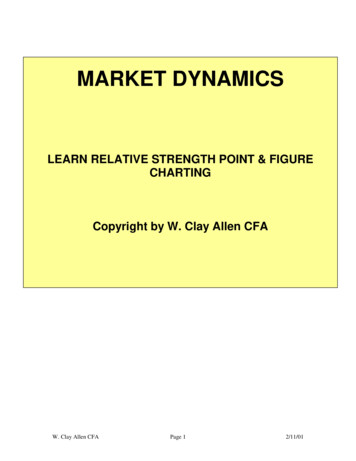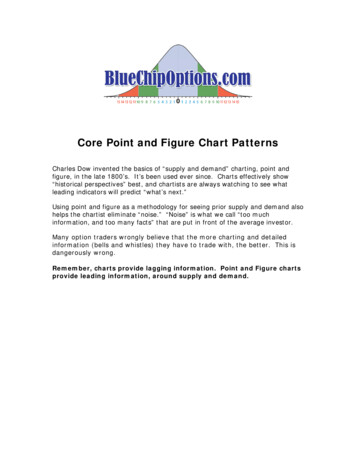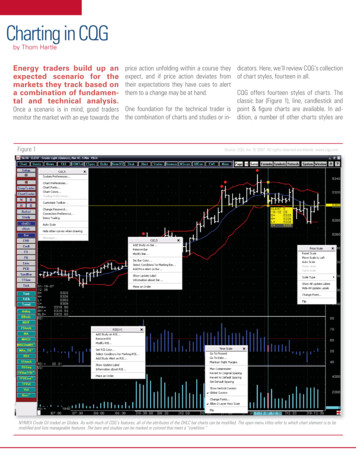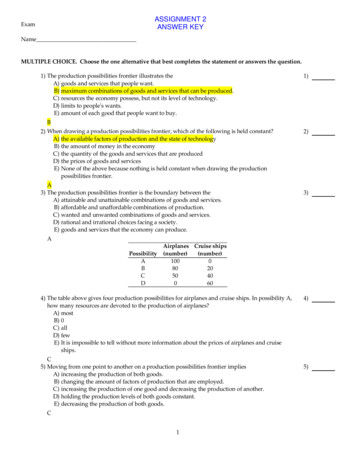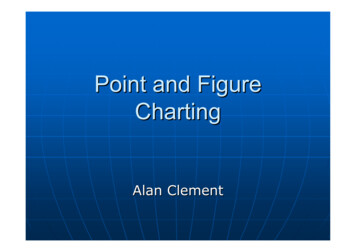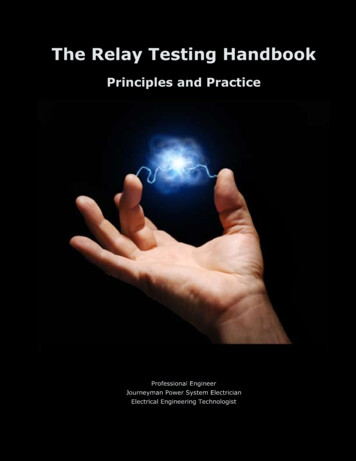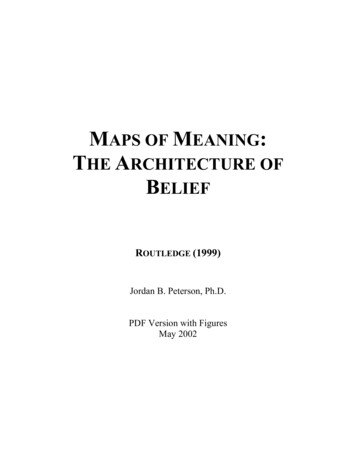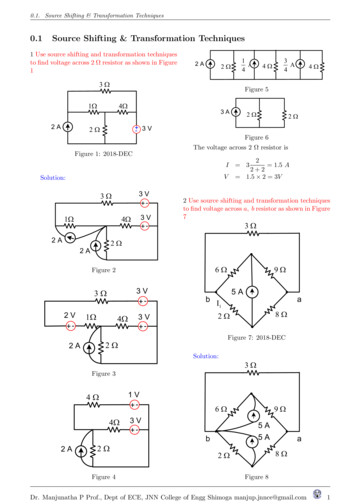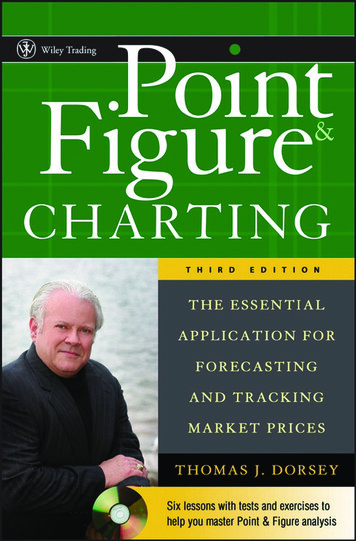
Transcription
dors a01ffirs.qxd1/31/073:06 PMPage iiiPOINT ANDFIGURE CHARTINGThe Essential Application forForecasting and Tracking Market PricesThird EditionThomas J. DorseyJohn Wiley & Sons, Inc.
dors a01ffirs.qxd1/31/073:06 PMPage iPOINT ANDFIGURE CHARTING
dors a01ffirs.qxd1/31/073:06 PMPage iiPOINT AND FIGURE CHARTINGFounded in 1807, John Wiley & Sons is the oldest independentpublishing company in the United States. With offices in NorthAmerica, Europe, Australia, and Asia, Wiley is globally committed to developing and marketing print and electronic products andservices for our customers’ professional and personal knowledgeand understanding.The Wiley Trading series features books by traders who havesurvived the market’s ever changing temperament and have prospered—some by reinventing systems, others by getting backto basics. Whether a novice trader, professional, or somewherein-between, these books will provide the advice and strategiesneeded to prosper today and well into the future.For a list of available titles, please visit our web site atwww.WileyFinance.com.
dors a01ffirs.qxd1/31/073:06 PMPage iiiPOINT ANDFIGURE CHARTINGThe Essential Application forForecasting and Tracking Market PricesThird EditionThomas J. DorseyJohn Wiley & Sons, Inc.
dors a01ffirs.qxd1/31/073:06 PMPage ivCopyright 1995, 2001, 2007 by Thomas J. Dorsey. All rights reserved.Designations used by companies to distinguish their products are often claimed astrademarks. In all instances where John Wiley & Sons, Inc. is aware of a claim, theproduct names appear in initial capital or all capital letters. Readers, however, shouldcontact the appropriate companies for more complete information regarding trademarksand registration.Published by John Wiley & Sons, Inc., Hoboken, New Jersey.Published simultaneously in Canada.Wiley Bicentennial Logo: Richard J. PacificoNo part of this publication may be reproduced, stored in a retrieval system, ortransmitted in any form or by any means, electronic, mechanical, photocopying,recording, scanning, or otherwise, except as permitted under Section 107 or 108 of the1976 United States Copyright Act, without either the prior written permission of thePublisher, or authorization through payment of the appropriate per-copy fee to theCopyright Clearance Center, Inc., 222 Rosewood Drive, Danvers, MA 01923, (978) 7508400, fax (978) 646-8600, or on the web at www.copyright.com. Requests to thePublisher for permission should be addressed to the Permissions Department, JohnWiley & Sons, Inc., 111 River Street, Hoboken, NJ 07030, (201) 748-6011, fax (201) 7486008, or online at http://www.wiley.com/go/permissions.Limit of Liability/Disclaimer of Warranty: While the publisher and author have usedtheir best efforts in preparing this book, they make no representations or warrantieswith respect to the accuracy or completeness of the contents of this book andspecifically disclaim any implied warranties of merchantability or fitness for aparticular purpose. No warranty may be created or extended by sales representatives orwritten sales materials. The advice and strategies contained herein may not besuitable for your situation. You should consult with a professional where appropriate.Neither the publisher nor author shall be liable for any loss of profit or any othercommercial damages, including but not limited to special, incidental, consequential,or other damages.For general information on our other products and services or for technical support,please contact our Customer Care Department within the United States at (800) 7622974, outside the United States at (317) 572-3993 or fax (317) 572-4002.Wiley also publishes its books in a variety of electronic formats. Some content thatappears in print may not be available in electronic books. For more information aboutWiley products, visit our web site at www.wiley.com.Library of Congress Cataloging-in-Publication Data:Dorsey, Thomas J.Point & figure charting : the essential application for forecasting andtracking market prices / Thomas J. Dorsey. -- 3rd ed.p. cm. — (Wiley trading series)Includes index.ISBN-13: 978-0-470-04351-6 (cloth/cd-rom)ISBN-10: 0-470-04351-2 (cloth/cd-rom)1. Stocks—Prices—Charts, diagrams, etc. 2. Speculation. 3. Stockprice forecasting. I. Title. II. Title : Point and figure charting.HG4638.D67 2007332.63'222—dc222006031242Printed in the United States of America.10987654321
dors a02ftoc.qxd1/31/073:08 PMPage vCONTENTSAcknowledgmentsviiPart OneLearn the Point and Figure MethodologyChapter 1Introduction3Chapter 2Point and Figure Chart Fundamentals21Chapter 3Chart Patterns55Chapter 4Foundations of Relative Strength103Chapter 5Advanced Relative Strength Concepts141Chapter 6Primary Market Indicators for Gauging Risk177Chapter 7Secondary Market Indicators223Chapter 8Sector Rotation Tools249Part TwoThe Point and Figure Methodology—A Complete Analysis ToolChapter 9Fixed Income Indicatorsv279
dors a02ftoc.qxd1/31/073:08 PMviPage viContentsChapter 10 Utilizing the Exchanged Traded Fund Market295Chapter 11 Evaluating the Commodity Marketfor Opportunities323Part ThreeApply the Point and Figure Methodologyto Your Investment ProcessChapter 12 Portfolio Construction and Management361About the CD-ROM371Index375
dors a03flast.qxd1/31/073:10 PMPage viiACKNOWLEDGMENTSIt’s been 11 years since the first edition of Point and FigureCharting was printed and 20 years since Watson Wright and Iwalked down Main Street in Richmond, Virginia, to our newquarters, Dorsey, Wright & Associates (DWA). Watson and I havebeen together for the better part of 26 years, almost as along as Ihave been married to my wife Cindy. Watson and I have found away to make 1 1 3. Our partnership has worked well for 20years and I look forward to another 20 years.The first edition of Point and Figure Charting was a labor oflove. I knew it had to be written if for no other reason than to express my gratitude for having being shown my manifest destinyand giving me a vision to develop DWA with Watson. As soon as Ilearned this method of investment management, I knew I had topass the word to any and all investors who were searching for amore secure financial future. The success of the first edition andthe consistency of sales told me this was the right method for themajority of investors. When John Wiley asked me to write thesecond edition I knew it would be an all-hands evolution. We haddeveloped many new concepts for Point and Figure analysis overthe years similar to the spokes extending from the hub of a bicycle wheel. My two top analysts, Tammy and Susan, joined in withme in writing the second edition. Tammy and Susan have beenwith DWA since the beginning and are like family to me. Theyhave accumulated 20 years each in experience in this method ofinvestment analysis. In my opinion, they are the best on theplanet when it comes to our little slice of Wall Street.Well, here we are five years after the debut of the second edition and John Wiley & Sons asked me to write the third editionvii
dors a03flast.qxdviii1/31/073:10 PMPage viiiAcknowledgmentsof the book. It was quite fortuitous, because we at DWA had justbeen discussing the need for a third edition for many reasons.There has been a whirlwind of changes on Wall Street these pastfive years. We experienced the end of a 20-year bull market, thebeginning and the end of a major bear market, and the beginningbut not the end of what I called a “structural fair market.” Here’swhy the book is necessary at this time. The structural fair market is simply my way of saying that the market is likely to movesideways for many years; however, it will experience many upand down moves of 20 percent or more. Skill at Sector Rotationwill be the key to success during this period. Sectors will movein and out of favor as produce does in the supermarket. Since2002, this has been the case. Since 1998, the market as dictatedby the S&P 500 has gone nowhere. A quick look at the Point andFigure chart in July 1998 shows a high of 1175 and here we areeight years later and the S&P 500 is at 1220. Investors are aboutto experience a lost decade. Wall Street has had to come to gripswith the fact that the buy-and-hold theory is simply not workingfor their investors. It is because of these changes that we too havechanged, focusing much more on sector rotation and relativestrength. Also the debut of the Exchange Traded Fund, the mostimportant new product I have seen in my 32 years on Wall Street,is discussed in detail in this book, expanding extensively the discussion we began in the second edition. This third edition ofPoint and Figure Charting deals with what is happening today inthe markets, examines the forces of supply and demand that willcontinue to drive the markets, and provides a framework thatwill be instrumental in helping investors both professional andindividual in growing their assets so a comfortable retirementcan become a reality.To accomplish writing this book in a timely manner requiredthat I rope in all the analysts who live with these concepts andmethods day in and day out. Jay Ball who is first an analyst andsecond in charge of our whole database was instrumental in creating the study guide CD that accompanies this book. Jay has madesome incredible advances in our web-based Productivity Systemwith the help of Justin Knight who makes sure the nuts and boltsof our system are greased and operating at top efficiency. I amcontinually amazed each and every day I use this Productivity
dors a03flast.qxd1/31/073:10 PMPage ixAcknowledgmentsixSystem. It truly takes you to the edge of what some call the future. Paul Keeton didn’t escape the net of this monumental project either. Paul has been with DWA for six years now and hasrisen to become one of our top analysts. He writes for our research reports daily and is instrumental in much of the creativethought process at DWA. Paul’s fingerprints are on just abouteverything we do. We consulted frequently with Steve Raymondwhen it came to mutual funds—also a new addition to this book.Steve heads up our mutual fund department and is one of the bestmanagers on Wall Street in this area. When you read the book andsee all those fantastic charts and graphs, think of Sarah Lepley.She is a sophomore at Pennsylvania State University and is nowin her second year of internship at DWA. She has done such agreat job here we entrusted her with the visual portions of thebook. It’s amazing that we were able to martial such brainpowerto accomplish one task. We have had zero turnover of key personnel in DWA’s 20 years. Each person here simply becomes betterand better at what he does. We have 10 full-time employees in thehome office at DWA. We also hire five or more of the best mindsthe local universities can provide us each year as interns. We tryto make our intern force as international as possible and have hadinterns from Bolivia, Ghana, Spain, Estonia, and Germany toname just a few of the countries represented.Watson Wright is my partner, but Tammy DeRosier is myright hand. She headed up the whole operation for this third edition. Without her help, it might have taken another year to finishthis book. Heading up this operation was a massive undertakingfor her mainly because it was in addition to her other management duties at DWA. We write over 5,000 pages of original research each year at DWA but the logistics of choreographing andconstructing a book suitable for publishing at a major publishinghouse is a different task all together. Tammy is like the foremanon the DWA Ranch. She has been working at DWA since she was16 and worked her way through the University of Virginia, working vacations and weekends at the company.Susan is the head of all stock research at DWA. She was thefirst person outside Watson and me to work at DWA. Sue was amunicipal bond trader at Signet Bank in Richmond, and heard mespeak at a bank function one night. That was all it took; she
dors a03flast.qxdx1/31/073:10 PMPage xAcknowledgmentsembraced a method of investing that would become her businesslife from that night forward. She is world class without a doubtand she is one of the integral parts of this family. Susan alsoworked her way through Virginia Commonwealth Universitywhile working at DWA.As with everything we do at Dorsey, Wright, this book is afamily affair. I hope you enjoy the book; our heart is in it.
dors c01.qxd1/31/073:11 PMPage 1Part OneLEARN THEPOINT AND FIGUREMETHODOLOGY
dors c01.qxd1/31/073:11 PMPage 2
dors c01.qxd1/31/073:11 PMPage 3Chapter 1INTRODUCTIONPoint and Figure Charting: A Lost ArtI would never have thought we would be embarking on the thirdedition of this book when I wrote the first edition. I know nowthat this will not be the last edition either. Technology and theInternet have significantly changed the way we approach technical analysis. Over the years, we have been able to develop newand interesting indicators that the founders of the Point and Figure method over a hundred years ago could not have fathomed.Dorsey, Wright & Associates (DWA) has been in business for 20years now and the changes we have seen are amazing. When wefirst started DWA, we used a Tandy 3000 computer that was considered to be state of the art. We did not have enough money tobuy it outright, so we leased it. When all of those rent paymentswere totaled up, that computer cost 3,000 and only did a smallfraction of what computers today can do that cost one-tenth theprice. Twenty years ago, there was no such thing as an onlinecharting system. We updated 2,500 stock charts by hand for closeto a decade. Our Relative Strength charts were updated by handonce a week. It was a right of passage for each intern to maintainthe Relative Strength charts each week. Distribution of our research each day was done by fax machine. The machine we usedto fax out our 20-page report each day cost 1,800. This fax machine was state of the art technology, and we borrowed it from3
dors c01.qxd41/31/073:11 PMPage 4Learn the Point and Figure Methodologyfriends. Since we had no money, only debt, in the beginning wehad to go downstairs each day and fax out our report by hand,page by page. This machine could only fax to one phone numberat a time. This was in 1987. I think we paid seven cents a page touse this fax. When you start a business with nothing, you do whatyou have to do to make it work. By 1994, we were on the Internet;however, our clients were not up on that technology curve yetand still wanted our reports by fax. Those who wanted to takedown stock charts did so through the, by then, outdated DOS system. Most of us will hold on to the old way of doing things whennew technology and new ways of doing things come into existence. This is called the technology gap. I remember one of thelargest brokerage firms on Wall Street saying the Internet was aflash in the pan, and they were not putting any significant resources into it. We knew from the start how important this newtechnology would be and put all our resources into it. With thisnew technology, we were able to begin creating new and important indicators that stemmed from the Point and Figure methodof analysis. We continue to push the envelope with technology,and every few years we have new and innovative things we havecreated to help investors and professionals become more successful at the investment process. This is why I am sure that at somepoint in the future there will be a need for Point and FigureCharting, Fourth Edition. For now we have more than enoughnew things to discuss in the Third Edition.Let’s start with the basics. The Point and Figure method is notnew by any stretch of the imagination. It is, however, a lost artsimply because most investment professionals and individual investors have lost sight of the basics that cause fluctuations in theprices of securities. Even though we have been championing thismethod of analysis for 20 years, we have barely made a dent in the50 million investors in America. We’ve scratched the surface;that’s about all, and our business has grown every year for 20years. We have a lifetime of work ahead of us. In today’s rapidlyevolving technologies, the irrefutable law of supply and demandhas been all but forgotten and that is one thing that doesn’tchange in any market. In the end, the only thing that will outlivetechnological change that is truly sustainable is the transcendent
dors c01.qxd1/31/073:11 PMPage 5Introduction5competence of an individual’s workmanship. New methods of security analysis continue to crop up capturing the ever-expandingcuriosity of the investing public. It seems everyone is searchingfor the Holy Grail, yet few are willing to become craftsmen at theinvestment process. Many are looking for a computer programthat will define the winning trades each day without any effortfrom the investor or professional who has ultimate responsibilityfor the portfolio of stocks. A long time ago when I was a stockbroker at a major firm on Wall Street, I learned there is no HolyGrail. The key to success in this business, and any business forthat matter, is confidence. According to my dictionary, confidence means “firm belief or trust; self-reliance; boldness; assurance.” In the securities business, the key term in that definitionis self-reliance, and it is the one trait most investors and stockbrokers lack. Investors today are increasingly averse to makingtheir own decisions, which is why the mutual fund business hasgrown to record levels. Not only that, investors look to the television to provide them ideas on where to invest their hard-earnedmoney. There are also investors who have taken control of theirown investments and of their training and education in the investment process. The irony is that 75 percent or more of professional money managers never outperform the broad stock marketaverages, so looking for professional help has proved ill fated inmany cases. Nevertheless, most investors look at the stock market as an enigma. It confounds them that the market reacts inwhat seems to be an illogical pattern. Increased earnings expectations should result in price appreciation of the underlying stock,right? Not necessarily. In many cases, the opposite happens. Inthe year 2000, we saw exactly that. Stocks with great fundamentals collapsed under their astronomical valuations. Companieslike Lucent Technologies declined from 80 to the single digits.Major firms on Wall Street were in love with the stock’s fundamentals at 80. Lucent’s only problem was not in the company itself, but in its customers’ ability to pay for the products they hadpurchased from Lucent. This information did not show up in thefundamental research until the stock collapsed. It did, however,show up in the Point and Figure chart. Those who were wellversed in evaluating the supply demand relationship of the stock
dors c01.qxd61/31/073:11 PMPage 6Learn the Point and Figure Methodologysaw trouble early on. The game of golf is like the market, oftencounterintuitive. It took me a long time to realize that the harderI hit at the ball the less distance it would go. I found that if I hitdown on the ball it made the ball go up. Like I mentioned earlier,the market, like golf, can often seem counterintuitive.Over the past 11 years, since the first edition of this book waspublished, my confidence in this methodology has increasedtremendously. While nothing in the method has changed, how weuse it has expanded and grown. We have developed a number ofnew indicators, many based on the Bullish Percent and RelativeStrength concepts covered in the first edition, and have foundnew ways to use many of the old indicators. One of the most interesting and useful products that was just coming into existencewhen the last edition was published was the Exchange TradedFund. This class of investment vehicle is growing by leaps andbounds and I think it is the most important new product to hitthe market in my 30 plus years in the business so we discuss thisinvestment vehicle extensively throughout the entire book.In the past five years, we have gone through some of the mostvolatile markets anyone has seen. Negotiating the markets in thisvolatile and changing economy points out the need for an operating system to guide investors. This book provides that operatingsystem. The old paradigm of buying quality stocks with real products and visible earnings has gone right out the window. At leastthe media and most investors think so. In the late 1990s, themantra on Wall Street was: “Forget earnings they aren’t important, only revenues are important.” We heard 22-year-old CEOssuggesting that the old-line companies, the backbone of theUnited States, “just don’t get it.” Well, the crash of the dot-comcompanies that thought they “got it” has awakened Americans toa market that both gives and takes away. The 22-year-old CEOs“didn’t get it.” Investors have come to realize that real wealth ismade in the stock market. They have also come to realize that themarket can take it away just as fast. Attention to the bottom lineis now back in vogue as investors recognize that net earnings arein fact important. In the latter part of the 1990s, firms attemptedto create brand names by simply throwing millions of dollars intoadvertising. Companies were trying to create solid brand namesin one month that took companies like Procter & Gamble 40
dors c01.qxd1/31/073:11 PMPage 7Introduction7years to create. Some companies even sell products below cost,with the expectation of making up the difference in advertisement revenues.This all came to roost in the second quarter of 2000 whenthe Nasdaq stocks literally melted down in a matter of a fewweeks. All of a sudden, the market that once valued The StreetDot Com (TSCM) at 71 now valued it at 3. MicroStrategy(MSTR) once traded as high as 330, fell to 14, and is now backto 108. The high-flier Priceline.com was as high as 165, declined to 5, and is now at 22. How quickly the market correctsover exuberance, as Alan Greenspan warned. The high-flierswere not the only ones that were hit in 2000; some stocks, manyNew York Stock Exchange names, hit their peaks in 1998 andare just beginning to show signs of life again. Quality companieslike Eastman Kodak, Cisco Systems, AT&T, Worldcom, and virtually countless others have seen their stocks become burnedout stars as their stock prices have been cut in half or worse.There was basically nowhere investors could hide. It was an interesting market from April 1998 to March 2000 in which theindexes did fairly well while the stocks underlying them werekillers. Since 2000, the Dow Jones, only considering pricechange, no commissions to buy it and no dividends, is down 2.5percent at this writing in 2006. So a buy-and-hold investor, whowanted the safety of the largest capitalization stocks availabletoday, would have basically been spinning his wheels for thepast five and a half years. If, however, an investor had a way toknow that the play was in small capitalization (small cap)stocks, not large capitalization (large cap) stocks, and bought theStandard & Poors Small Capitalization Universe stocks, he orshe is up 90 percent at this writing in 2006.You know what concept never wavered once during thistreacherous period? It was the irrefutable law of supply and demand. In almost all the cases cited, the charts foretold troubledown the road and they also foretold demand taking control in instances like the small cap stocks. In later chapters, I point outhow these supply-and-demand indicators “saw” the 2000/2002crash coming and told us the risk was high. We were then able toget our clients out of harm’s way. We have once again gonethrough a market condition never seen before. The Internet has
dors c01.qxd81/31/073:11 PMPage 8Learn the Point and Figure Methodologyinjected change into the whole game on Wall Street. Barriers toentry in almost any business are nonexistent and the freedom ofthe Internet brings tremendous competition. The playing field isbeing leveled every day. The one constant that has not changed inover 100 years is supply and demand and the Point and Figuremethod of analyzing markets. It’s interesting that the Internetstocks that became so inflated and eventually collapsed are thevery stocks that have the most potential in the weeks and monthsahead. The Internet is here to stay and, in my opinion, is only inthe first foot of a 26-mile marathon. Knowing “when to hold ’emand when to fold ’em,” is the key to success.What Do Investors Have in Commonwith an 18-Year-Old Bungee Jumper?The answer is no fear. During the 1990s, investors came to believe that buying the dips is the key to success: Stocks alwayscome back, don’t panic; just buy more. Some people leveragedtheir homes to put money in the stock market. This kind of situation never ends well, and in the year 2000 it didn’t. The crash inNasdaq stocks caught just about everyone off guard, and massivelosses were generated buying the dips, averaging good moneyafter bad. I don’t believe investors have broken this habit yet, because not a week goes by that I don’t talk to someone who stillowns a Cisco Systems or SunMicrosystems or Microsoft in theiraccount. Many investors have recently turned to the real estatemarkets but now that the housing markets are losing strength, investors are wondering if there is a safe haven anywhere on the investing landscape. The only safe harbor an investor has is his owneducation and training in the investment process.The “buy every dip” mentality is what I call false courage.False courage is confidence you may feel when under the influence of alcohol or drugs. It dulls the senses and gives you the confidence to do things you otherwise would not consider. A friendof mine, the late Cornelius Patrick Shea, used to say, “My pappyuse to tell me the ‘sauce’ makes ya say things ya don’t mean andbelieve things that ain’t true.” The “sauce” for investors consisted of the seemingly never-ending rise in high-flying tech
dors c01.qxd1/31/073:11 PMPage 9Introduction9stocks and of late in real estate. It was so intoxicating that investors were “saying things they didn’t mean (buy 1,000 more)and believing things that weren’t true (revenues are increasingwith no end in sight).” During the latter part of the 1990s andfirst quarter of 2000, investors were enamored with the seemingly never-ending ascent of the stock market and in particularthe Nasdaq. The media aided this belief with the ceaseless chantof zero inflation and endless increases in worker productivity dueto technological advances. Because of their intoxication, investors kept taking more risks through leverage in high volatilitystocks beyond any rational measure. I even had a broker call mewith a story of how her aunt was not allowed to use margin at herfirm because of her advanced age (she was 80). Do you know whatshe did? She took a second mortgage out on her house, put themoney in her stock account, and continued trading. In essence,she skirted the brokerage firm’s margin requirement and margined the account anyway with the money the bank loaned herwhen she margined her house. I wonder how she fared after thecrash of March 2000, May 2000, and November 2000. She mayhave lost her house.The decline in stocks from 2000 to 2002 certainly woke manyan investor up to the fact that markets go both ways—up anddown. But I also fear that markets of 2003 through 2006 havelulled investors back to sleep. From July 1998 to present, someone who bought and held the S&P 500 is finding him- or herselfwith an annualized rate of return of about 1 percent per year. Youmight first think, that’s not too bad, at least I didn’t lose anymoney. But the fact of the matter is for a great many people thatmeans you have lost, although maybe not in actual dollars, almost a decade of investing. When you consider that so many investors were made to believe that they would get 11 percent ayear rate of return on equities, dropping that just 1 percent a yearcan really put a dent in your retirement planning. Not only areyou not making any headway, but you’ve now lost eight years.Many investors have forgotten that having a logical, organized,well-founded method of investing in the markets is the only wayto success. Haphazard, overleveraged, method-less investing willalways lead to disaster, just as it did in 2000. The Nasdaq not onlycorrected, it headed south like a migrating bird. Its decline was so
dors c01.qxd101/31/073:11 PMPage 10Learn the Point and Figure Methodologyswift that, in a matter of weeks, it had lost 37 percent from itshigh, and that even masked what happened to so many stocks.Many individual stocks lost 80 percent or more of their value. Investors with a whole portfolio of high-tech/high-wreck Internetand technology stocks may not see the light of day in their accounts for many years to come, and it’s now 2006. The averagegain in the stock market over the past 80 years is around the 10percent level. If an investor loses 50 percent of his portfolio value,that portfolio will have to rise 100 percent to get back up to even.How long will that take at an average 10 percent per year? Aboutseven years. We are now five and a half years after the bottom andthe Dow Jones has not made any headway. If an investor boughtat the top in 1973 and rode the market down, it took seven and ahalf years to get even. Can you wait seven and a half years to getyour money back if you ride a bear market down as the media andmutual funds suggest you should do? If your answer is no, thenyou are ultimately interested in risk management, which is whatthis book is all about.I was in a store the other day purchasing a new laptop computer. I got into a conversation about investing in the marketwith the head of the computer department. He was having a hardtime understanding what I did. I told him that successful investing requires an operating system like the one in every c
Chapter 2 Point and Figure Chart Fundamentals 21 Chapter 3 Chart Patterns 55 Chapter 4 Foundations of Relative Strength 103 Chapter 5 Advanced Relative Strength Concepts 141 Chapter 6 Primary Market Indicators for Gauging Risk 177 Chapter 7 Secondary Market Indicators 223 Chapter 8 Sector Rotation Tools 249. Part Two. The Point and Figure .

